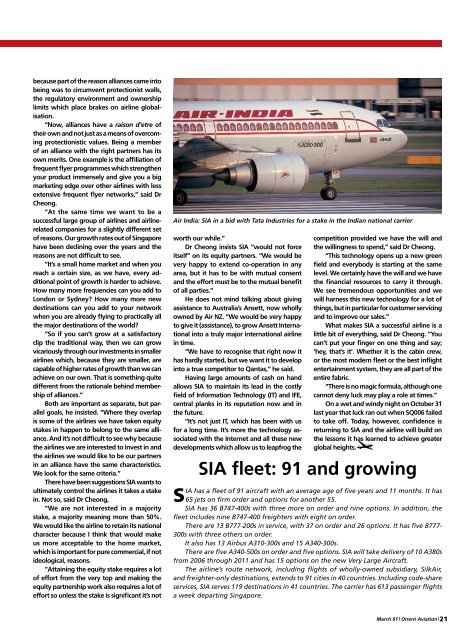LIFE AFTER SQ006 - Orient Aviation
LIFE AFTER SQ006 - Orient Aviation
LIFE AFTER SQ006 - Orient Aviation
- No tags were found...
You also want an ePaper? Increase the reach of your titles
YUMPU automatically turns print PDFs into web optimized ePapers that Google loves.
ecause part of the reason alliances came intobeing was to circumvent protectionist walls,the regulatory environment and ownershiplimits which place brakes on airline globalisation.“Now, alliances have a raison d’etre oftheir own and not just as a means of overcomingprotectionistic values. Being a memberof an alliance with the right partners has itsown merits. One example is the affiliation offrequent flyer programmes which strengthenyour product immensely and give you a bigmarketing edge over other airlines with lessextensive frequent flyer networks,” said DrCheong.“At the same time we want to be asuccessful large group of airlines and airlinerelatedcompanies for a slightly different setof reasons. Our growth rates out of Singaporehave been declining over the years and thereasons are not difficult to see.“It’s a small home market and when youreach a certain size, as we have, every additionalpoint of growth is harder to achieve.How many more frequencies can you add toLondon or Sydney? How many more newdestinations can you add to your networkwhen you are already flying to practically allthe major destinations of the world?“So if you can’t grow at a satisfactoryclip the traditional way, then we can growvicariously through our investments in smallerairlines which, because they are smaller, arecapable of higher rates of growth than we canachieve on our own. That is something quitedifferent from the rationale behind membershipof alliances.”Both are important as separate, but parallelgoals, he insisted. “Where they overlapis some of the airlines we have taken equitystakes in happen to belong to the same alliance.And it’s not difficult to see why becausethe airlines we are interested to invest in andthe airlines we would like to be our partnersin an alliance have the same characteristics.We look for the same criteria.”There have been suggestions SIA wants toultimately control the airlines it takes a stakein. Not so, said Dr Cheong,“We are not interested in a majoritystake, a majority meaning more than 50%.We would like the airline to retain its nationalcharacter because I think that would makeus more acceptable to the home market,which is important for pure commercial, if notideological, reasons.“Attaining the equity stake requires a lotof effort from the very top and making theequity partnership work also requires a lot ofeffort so unless the stake is significant it’s notAir India: SIA in a bid with Tata Industries for a stake in the Indian national carrierworth our while.”Dr Cheong insists SIA “would not forceitself” on its equity partners. “We would bevery happy to extend co-operation in anyarea, but it has to be with mutual consentand the effort must be to the mutual benefitof all parties.”He does not mind talking about givingassistance to Australia’s Ansett, now whollyowned by Air NZ. “We would be very happyto give it (assistance), to grow Ansett Internationalinto a truly major international airlinein time.“We have to recognise that right now ithas hardly started, but we want it to developinto a true competitor to Qantas,” he said.Having large amounts of cash on handallows SIA to maintain its lead in the costlyfield of Information Technology (IT) and IFE,central planks in its reputation now and inthe future.“It’s not just IT, which has been with usfor a long time. It’s more the technology associatedwith the Internet and all these newdevelopments which allow us to leapfrog thecompetition provided we have the will andthe willingness to spend,” said Dr Cheong.“This technology opens up a new greenfield and everybody is starting at the samelevel. We certainly have the will and we havethe financial resources to carry it through.We see tremendous opportunities and wewill harness this new technology for a lot ofthings, but in particular for customer servicingand to improve our sales.”What makes SIA a successful airline is alittle bit of everything, said Dr Cheong. “Youcan’t put your finger on one thing and say;‘hey, that’s it’. Whether it is the cabin crew,or the most modern fleet or the best inflightentertainment system, they are all part of theentire fabric.“There is no magic formula, although onecannot deny luck may play a role at times.”On a wet and windy night on October 31last year that luck ran out when <strong>SQ006</strong> failedto take off. Today, however, confidence isreturning to SIA and the airline will build onthe lessons it has learned to achieve greaterglobal heights.SIA fleet: 91 and growingSIA has a fleet of 91 aircraft with an average age of five years and 11 months. It has65 jets on firm order and options for another 55.SIA has 36 B747-400s with three more on order and nine options. In addition, thefleet includes nine B747-400 freighters with eight on order.There are 13 B777-200s in service, with 37 on order and 26 options. It has five B777-300s with three others on order.It also has 13 Airbus A310-300s and 15 A340-300s.There are five A340-500s on order and five options. SIA will take delivery of 10 A380sfrom 2006 through 2011 and has 15 options on the new Very Large Aircraft.The airline’s route network, including flights of wholly-owned subsidiary, SilkAir,and freighter-only destinations, extends to 91 cities in 40 countries. Including code-shareservices, SIA serves 119 destinations in 41 countries. The carrier has 613 passenger flightsa week departing Singapore.March 01 | <strong>Orient</strong> <strong>Aviation</strong> | 21








![OAMag-V7N4-Cover [Converted] - Orient Aviation](https://img.yumpu.com/48598575/1/190x255/oamag-v7n4-cover-converted-orient-aviation.jpg?quality=85)







